Marble Mandir Design Ideas to Elevate Your Home Temple Space
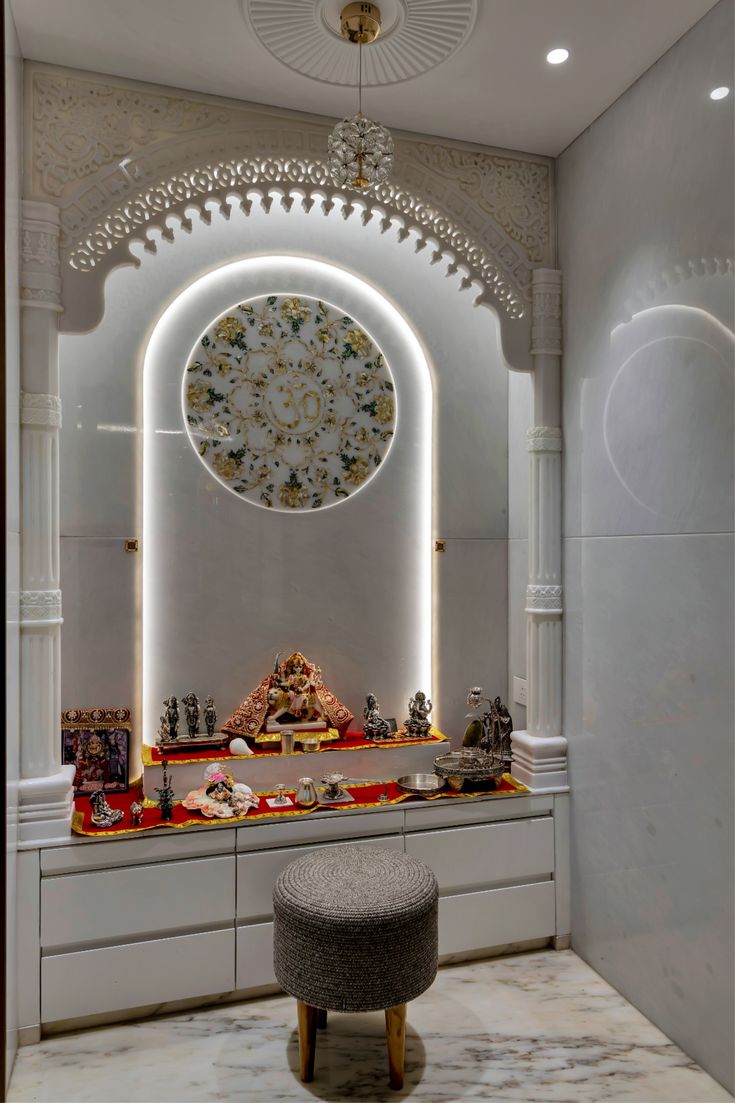
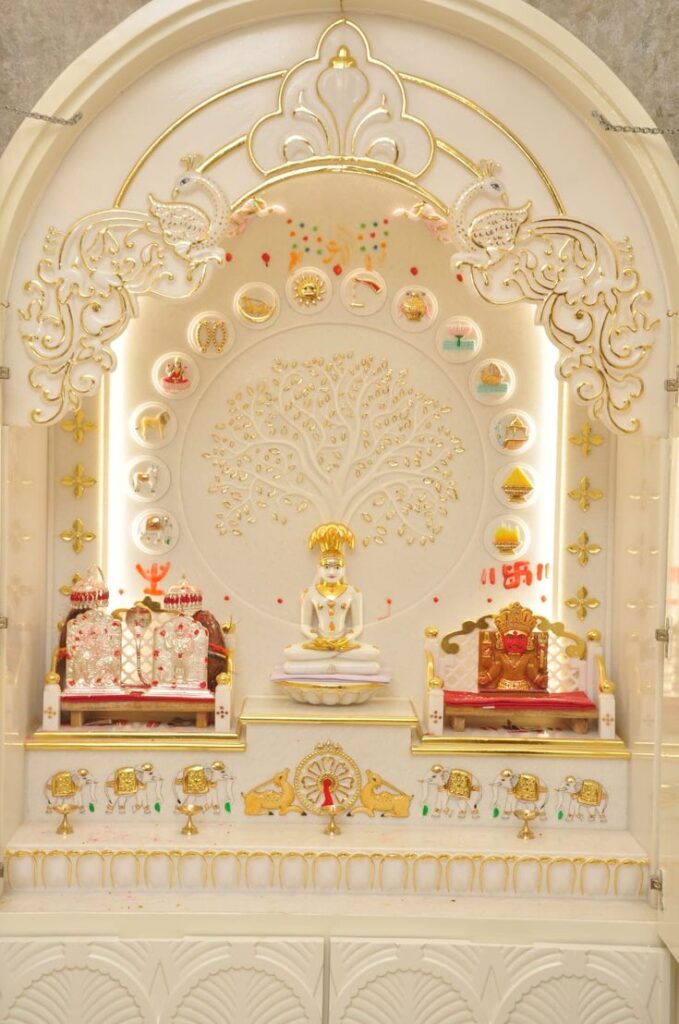
Benefits of Marble (Durability, Aesthetics, Spiritual Value)
Marble has long been revered in Indian culture for its purity and spiritual resonance. It is considered an auspicious material, making it ideal for pooja rooms and temples at home. Besides spiritual value, marble offers high durability and elegance. It doesn’t fade or deteriorate easily, allowing your marble mandir to look beautiful for years.
Its natural veining and textures bring uniqueness to each mandir. A polished marble finish enhances the divine aura, creating a serene and meditative atmosphere in your home temple. Moreover, marble complements both traditional and modern interiors seamlessly.
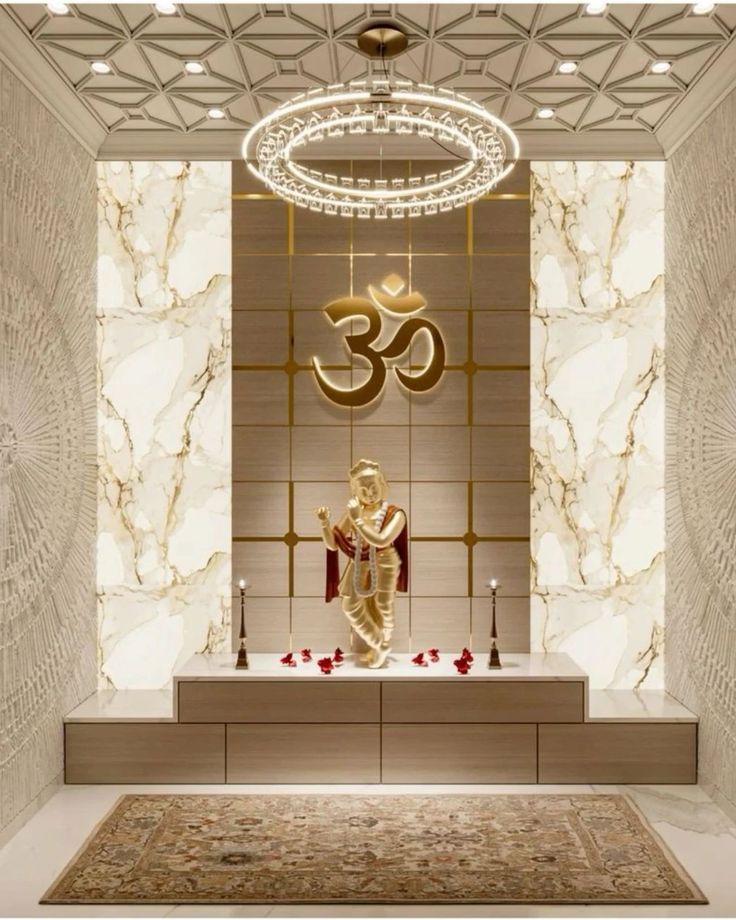
Comparison with Wood or Metal Pooja Mandirs
Wooden mandirs, while traditional, are more susceptible to damage from humidity and pests. Metal mandirs can feel impersonal and are prone to rust without proper care. In contrast, marble remains unaffected by climate changes and requires minimal upkeep.
Also, marble mandirs have a timeless aesthetic appeal. Unlike wood, marble doesn’t lose its color or structure over time. This makes it a one-time investment for your home’s long-lasting, spiritual space.
Symbolism in Religious Practice
In Hinduism, white marble is seen as a symbol of peace and purity. Having a marble pooja mandir promotes calmness and clarity during daily prayers. It is believed to amplify spiritual energies, making your worship rituals more effective and fulfilling.
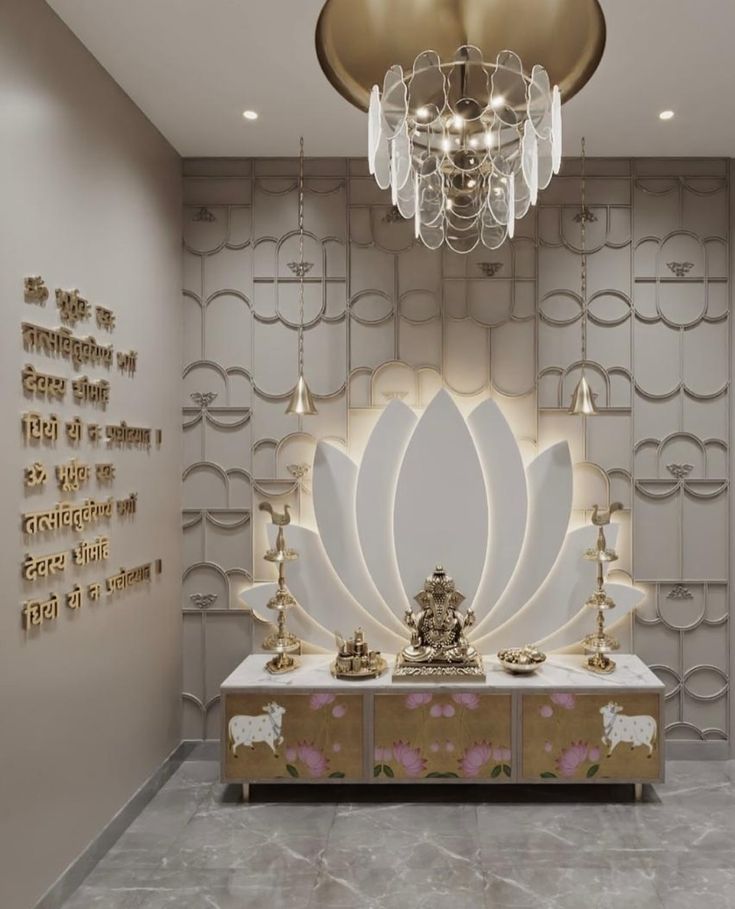
Types of Marble Mandir Designs
1. Traditional Marble Mandirs
Traditional marble mandirs are rich in Indian craftsmanship. They often include carved pillars, domes, and floral motifs, reminiscent of old temples in Rajasthan or South India.
These mandirs are often elaborate, with intricate jaali work and temple-style gopuras. They offer a majestic look and are ideal for those who prefer classic aesthetics in their pooja ghar.
In most traditional designs, you’ll also find steps leading up to the idol area, giving the setup a temple-like grandeur. The timeless appeal of these marble mandirs can become the spiritual centerpiece of any home.
2. Modern Marble Mandir Designs
Modern designs focus on simplicity and elegance. These marble temples feature sleek lines, geometric patterns, and minimalist motifs. The neutral tones of white or beige marble blend beautifully into contemporary homes.
Floating or wall-mounted mandirs are a popular trend. They save space while providing a neat and organized worship area. Often paired with ambient backlighting, they offer a sophisticated aesthetic.
Modern marble pooja mandirs also come with hidden storage or lighting features. These help maintain a clean look without compromising functionality or spiritual ambiance.
3. Marble Mandir with Back Panel Lighting
Incorporating LED backlighting enhances the marble texture and adds a serene glow to your temple space. Back panel lighting can be integrated into both traditional and modern designs.
You can choose warm yellow lights for a calming vibe or multi-colored LED panels for festive occasions. Lights highlight the carvings and give depth to the design, especially in the evening.
From a Vastu perspective, placing the light source in the northeast direction improves energy flow. Always opt for dimmable or soft lighting to maintain a peaceful worship environment.
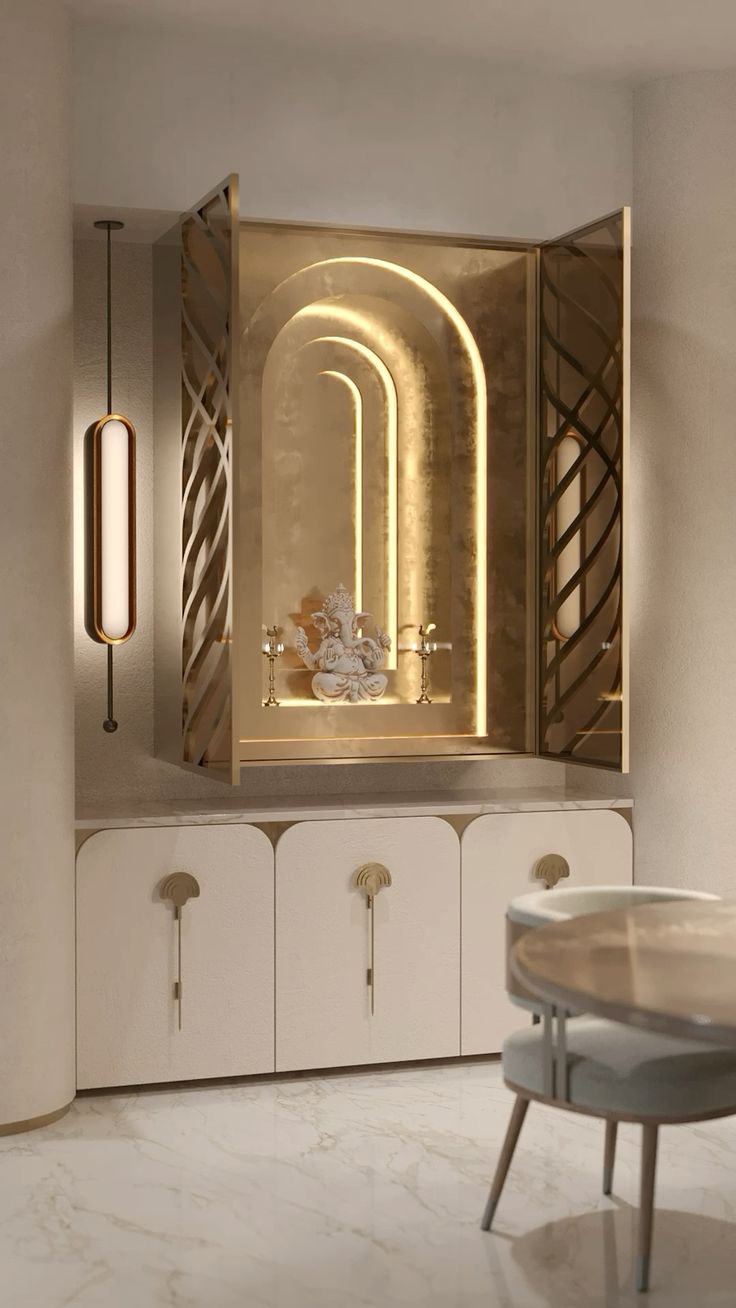
Choosing the Right Size and Location
Corner Marble Mandir for Small Apartments
For compact homes, a corner marble mandir is the best solution. It utilizes unused space efficiently while providing a dedicated area for spiritual practices. Compact mandirs can still have elegant carvings and features like jaali doors or backlights.
You can opt for an L-shaped or triangle base to snugly fit into the corner. These are perfect for studio apartments or homes with limited floor space.
To enhance the corner temple, add small brass bells or hanging diyas. This makes the area stand out despite its small size.
Floor-Mounted vs Wall-Mounted Units
Floor-mounted mandirs are traditional and ideal for spacious pooja rooms. They give a grounded, temple-like feel. On the other hand, wall-mounted marble mandirs are perfect for modern homes where saving space is essential.
Wall-mounted units are easier to clean under and around, offering better hygiene. They also create a floating visual effect that adds a modern touch.
Choose based on your home layout and the amount of space you can dedicate to spiritual activities.
Placement as per Vastu
According to Vastu Shastra, the ideal location for a pooja mandir is the northeast corner of your home. If that’s not feasible, north or east directions are the next best options.
Avoid placing the mandir near bathrooms or under staircases, as it is considered inauspicious. Ensure that the idols face west while you face east during prayers.
Proper placement not only aligns spiritual energy but also enhances harmony and well-being in your home.

Customization & Maintenance Tips
Custom Marble Engraving
Personalized engravings such as shlokas, lotus motifs, or deity names can add a unique touch to your marble mandir. Many artisans offer laser engraving or hand-carving based on your requirements.
Custom designs help blend the mandir into your home’s theme. You can also include your family name or a sacred symbol for a more personalized appearance.
Be sure to choose high-grade marble for custom work to ensure clean engravings and long-lasting beauty.
Cleaning Marble Without Damage
Use a soft, damp cloth and mild soap for regular cleaning. Avoid acidic cleaners, vinegar, or harsh chemicals, as they can etch the surface and dull the shine.
For deep cleaning, use a marble-safe polish. Make sure to dry the surface completely to prevent water stains.
Routine dusting and wiping will help retain the elegance of your marble temple. Always handle carved areas gently to avoid breakage.
How to Maintain Shine and Avoid Stains
Seal the marble every few years to protect against stains and moisture. This is especially useful in areas where oil or incense is used frequently.
Place a decorative mat or cloth under oil lamps or incense holders to catch any drips. This keeps the marble free from tough stains.
Avoid placing colored items directly on white marble, as they may leave stubborn marks.
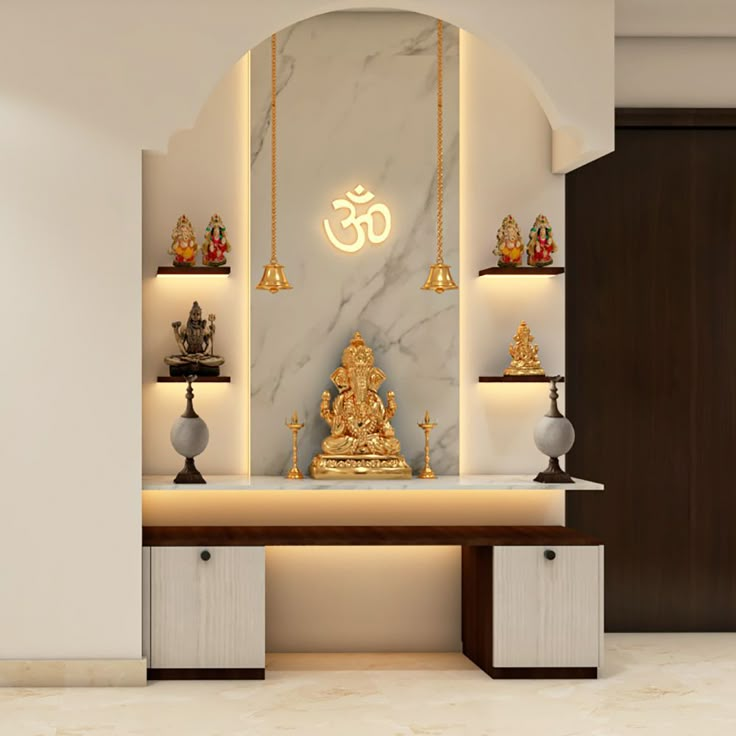
Cost of Marble Mandirs in India (2025 Update)
Price Range by Size, Quality, and Design
The cost of marble mandirs varies significantly based on size and complexity. A small wall-mounted unit can start from ₹10,000, while larger traditional mandirs can go up to ₹2 lakhs or more.
Premium quality marble like Makrana or Italian varieties increases the cost but adds to the aesthetic and durability.
Hand-carved or custom-designed mandirs naturally come at a higher price point due to the labor and craftsmanship involved.
Ready-Made vs Custom-Built Pricing
Ready-made mandirs are generally more affordable and available in various sizes and styles. They are a good choice for quick setup and budget-conscious buyers.
Custom-built marble mandirs, though more expensive, allow complete freedom in design, material, and features. This makes them perfect for those with specific home aesthetics or Vastu needs.
Think of it as a long-term investment for your spiritual well-being and home decor.
Additional Features That Affect Pricing
Add-ons such as lighting, carvings, storage drawers, and jaali work can significantly increase the cost. Marble thickness and polish finish also influence pricing.
Higher quality stones like Ambaji or Italian marble are priced per square foot and can increase the budget depending on quantity used.
Always ensure that the mandir is crafted from genuine marble to get true value for money.
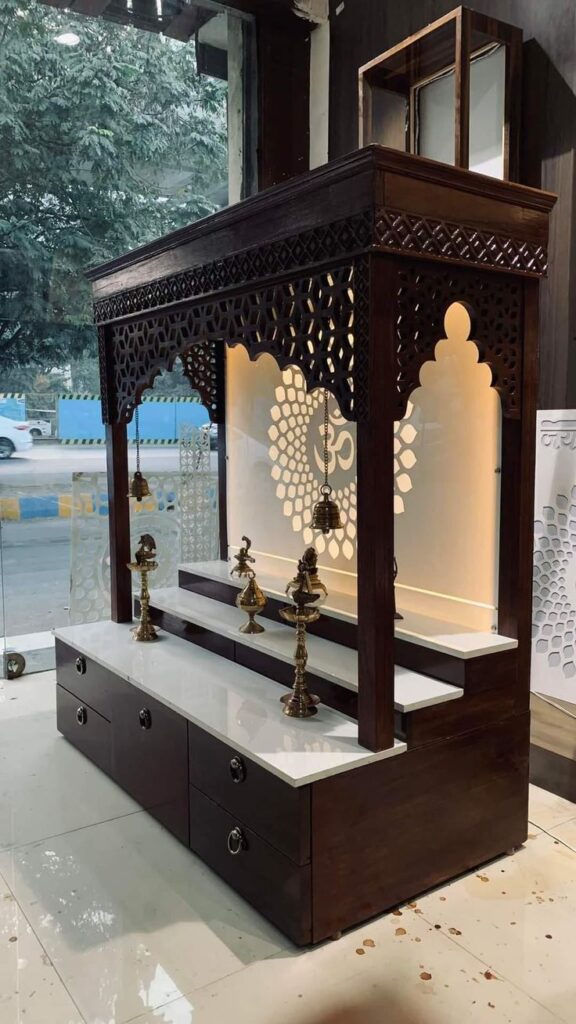
Top Marble Types Used in Pooja Mandirs
Makrana Marble
Known for its use in the Taj Mahal, Makrana marble is revered for its quality and whiteness. It’s highly durable, stain-resistant, and requires minimal maintenance.
This Indian-origin marble is perfect for both traditional and modern mandirs. Its natural elegance enhances the sanctity of any pooja room.
Because of its strength and minimal porosity, Makrana marble is a preferred choice for home temples.
Italian Marble
Italian marble is synonymous with luxury. Its smooth texture and elegant appearance make it a premium choice for modern mandirs.
Available in various shades like beige, cream, and gold, it matches contemporary interiors beautifully.
However, it is softer than Indian marble and requires sealing and extra care to maintain its shine.
Ambaji White Marble
This pure white marble is quarried in Gujarat and is known for its bright appearance and consistent texture. It’s ideal for pooja mandirs as it symbolizes peace and purity.
Ambaji white marble works well with carvings and engravings, making it perfect for customized temple units.
Its durability and non-porous nature make it easy to maintain and long-lasting.
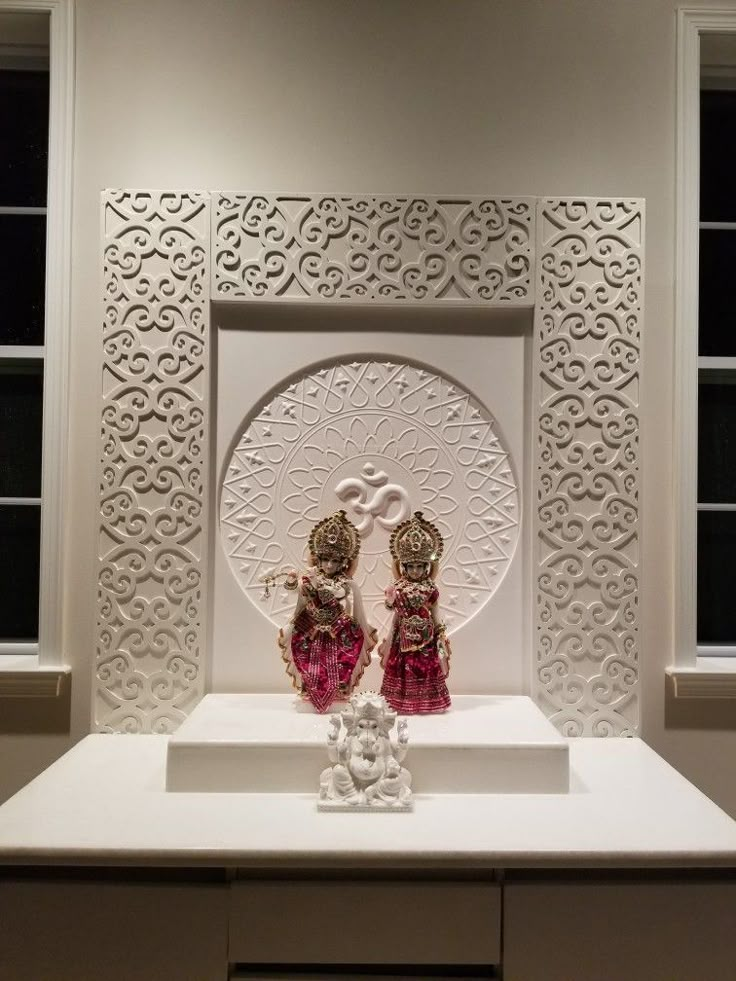
FAQs About Marble Mandir Design
Which Marble is Best for a Home Temple?
Makrana marble is often considered the best due to its purity, longevity, and low maintenance. Ambaji and Italian marbles are also excellent choices depending on design preferences and budget.
Choose a type that aligns with your home’s style and spiritual needs. Always look for non-porous, high-quality variants.
Is a Marble Mandir Vastu-Compliant?
Yes, marble mandirs are Vastu-compliant and enhance spiritual energies in your home. Place the mandir in the northeast direction and use white or light-colored marble for best results.
Avoid black or dark tones, as they are not considered auspicious in Vastu for temple spaces.
Can Marble Mandirs Be Wall-Mounted?
Absolutely. Wall-mounted marble mandirs are ideal for modern homes with limited space. They can be both functional and stylish.
Ensure strong wall support and proper fixing for safety. Choose compact yet elegant designs to suit your home’s aesthetics.

